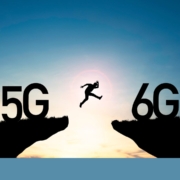6G Transition: Preparing for Next-Gen Networks
Current State of 6G
As the development cycle of the 5G era reaches the halfway mark (Check out this infographic!), the telecom industry has begun positioning for the commencement of the 6G era. The first set of 6G specifications is expected to be established in 2028 as part of the 3GPP (3rd Generation Partnership Project) Release 21 and initial commercial 6G network deployments are expected by 2030.
The telecom industry and global government entities have begun preparing for the 6G era via initiatives including determining criteria for standards development, establishing research consortiums and other strategic partnerships, identifying probable spectrum bands to support 6G, and exploring potential 6G use cases.
Telecom Industry and Government Entities Have Begun Preparing for 6G
Government Initiatives
Numerous countries and regions have begun pursuing initiatives to be at the forefront of 6G development. For example, in the U.S. the Federal Communications Commission’s (FCC) Technology Advisory Council established a 6G Working Group to provide recommendations to the FCC for 6G development. The Biden administration also recently announced the National Spectrum Strategy, which identifies potential future spectrum to support 6G (and 5G).
Other examples include South Korea launching a $325 million 6G commercialization and standardization R&D strategy; India establishing its Bharat 6G Vision, which aims for the country to launch 6G services by the end of 2030; and the European Union funding the Hexa-X research consortium, which includes leading vendors and operators. China has also begun embarking on research initiatives and experimentations to launch 6G by its target of the end of 2030.
Identifying 6G Spectrum
The clearance of additional spectrum in global markets will be essential in supporting escalating data traffic long-term as 6G is projected to support a 10x increase in usage on networks. Spectrum in the upper midband range (7GHz-24GHz) is being targeted as prime spectrum to support 6G as it is expected to provide an ideal balance of speed, propagation, coverage range and capacity.
Additional spectrum being considered for 6G includes lower-band spectrum (below 7GHz) due to its more widespread coverage range as well as millimeter wave spectrum due to its high bandwidth and capacity and low latency. Sub-terahertz spectrum (90GHz-300GHz) is also being explored for 6G, which would be able to support extremely high data rates though deployments would likely be limited to specific localized use cases, such as supporting holographic communications in a hospital or factory.
Use Case Exploration
6G is expected to support various use cases in areas including holographic communications, digital twins, AR/VR and autonomous robotics. Many of these types of use cases will have initially released to market during the 5G era but will gain greater adoption during the 6G era due to evolved network capabilities as well as supporting players such as device vendors providing more advanced accompanying solutions.
Network as a sensor is also being targeted, which will enable 6G networks to sense their surroundings to support a variety of use cases including public safety, healthcare and security. 6G will also enable operators to more cost-effectively support escalating data traffic on their networks as 6G provides advanced AI/machine learning (ML) capabilities and is more energy efficient than 5G.
Watch the Video Below to Learn How to Navigate the Telecom Industry as a Whole in 2024
Primary Driver for CSPs to Deploy 6G
Members of the telecom industry are cautiously optimistic about 6G due to its expected network efficiencies, ability to support escalating data traffic and potential 6G use cases. However, they are also voicing uncertainty and reservations around 6G, which is largely due to the high investment costs and limited monetization opportunities communication service providers (CSPs) have experienced in the 5G era.
Though 6G technical specifications and expected use cases are still in the developmental stages, TBR believes operators will be more calculated and tactical in investing in 6G compared to 5G, with a deeper emphasis on ensuring a clear line of sight to ROI before significant spending occurs.
The telecom industry has begun exploring 6G use cases, though the time frame for commercial readiness and the willingness of customers to pay for these solutions remain unknown. AR/VR use cases are a targeted area for 6G, including the metaverse and real-world simulations to provide training for users such as military personnel and first responders. Use cases around autonomous vehicles, advanced robotics, drones and 8K video are also key solutions being explored.
TBR expects the most beneficial use cases for 6G will involve the provisioning of advanced technologies that will enable operators to more cost-efficiently support rising traffic on their networks. For instance, deeper implementation of AI and ML technologies will enable operators to enhance self-optimizing network (SON) capabilities to realize cost efficiencies.
6G is also expected to result in deeper implementation of digital twins, which will help operators better anticipate potential outcomes to their networks and optimize their operations in areas including site management and field operations. Additionally, 6G is expected to be significantly more energy efficient compared to 5G, which will enable operators to improve cost efficiencies while helping to support corporate sustainability goals.
Conclusion
The telecom industry is on the cusp of the 6G era, with the first set of specifications expected to be established in 2028 and initial commercial deployments projected by 2030. Governments and industry players are actively preparing for this transition, with initiatives ranging from spectrum identification to use case exploration.
While there is cautious optimism about the potential of 6G, there are also concerns about the high investment costs and limited monetization opportunities that characterized the 5G era. However, with advancements in AI/ML capabilities, energy efficiency and the promise of transformative use cases, 6G is expected to offer significant benefits, including cost efficiencies and improved network performance.
As the industry continues to evolve, it will be crucial for stakeholders to carefully assess the ROI and strategic value of 6G investments.
Stay ahead of the curve with our latest insights and updates. Subscribe to Insights Flight now to receive exclusive content, expert tips, Q&A invitations and industry analysis straight to your inbox. Don’t miss out on the opportunity to elevate your knowledge and stay informed!




